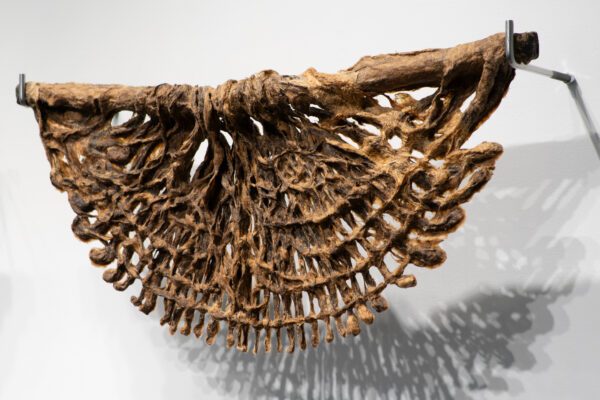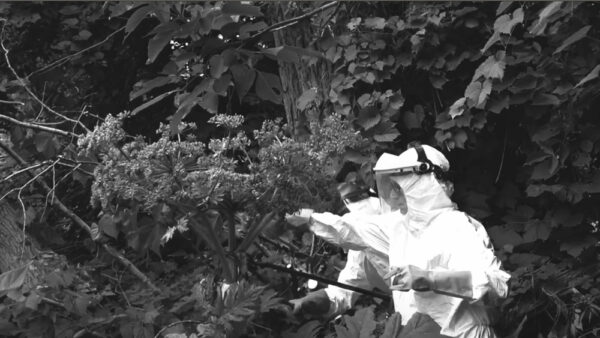
ALIENS
Colonial Narratives Through Plant Migration and Bio-Art
Artists: Supermrin, Adam Vackar
Curator: Isabella Indolfi
Exhibition Dates: June 1 – 23, 2024
Opening Reception: Saturday, June 1, 6-8 pm
Viewing Hours: Friday – Sunday, 1- 6 pm and by appointment
Eradicated, discriminated against, declared illegal and invasive: Plants, like humans, are victims of violent, colonial, and capitalistic cultures, and if they could speak, they would be able to tell the recurrent history of expropriation and domestication. The way humans perceive, act and legislate on the plant kingdom clearly reflects xenophobic sentiments toward their own species.
The exhibition “Aliens” offers a perspective on the politics of land and nature through two artists, Adam Vackar and Supermrin, who work with plants as their subject, medium, and primary source of inspiration as a way to explore concepts of domination and migration.
The history of the invasive Giant Hogweed of Eastern Europe and the history of the American manicured lawn separately convey ideologies of invasion and, juxtaposed, show how our concept of nature is shaped by colonial narratives.
Czech artist Adam Vackar’s documentary film, photographs, and installations delve into the complexities of human interaction with the Giant Hogweed, an invasive species originating from the Caucasus. Challenging the traditional perspective on migrating plants and the narrow-minded human approach to these organisms, the works trace this plant’s migration from Central Asia to Eastern Europe to the Americas. By analyzing the political eradication campaign directed against the Giant Hogweed, Vackar shows how the same rhetoric of invasion and illegality have been extended to living beings more generally —be they humans, animals or plants— that appear dissimilar, inconsistent, or otherwise opposed to the dominant system in a delimited environment.
US-based Indian artist Supermrin (Mrinalini Aggarwal) brings her latest project, FIELD, a bio-art project operating at intersections of sculpture, performance, bioethics, and arenas of urban space. Supermrin’s sculptures are made from waste lawn-clippings that she boils, washes and cooks in her kitchen to create a translucent, biodegradable bio-plastic, akin to a vegan leather. Supermrin’s artworks convey a sense of temporality, transience, and grotesque subjectivity, offering a plant-based perspective on a rewilded future. The FIELD project tells how manicured urban lawns convey an outdated American Dream, emblematic of capitalism and racism, that in a time of climate change are also symbolic of ecological destruction. Through FIELD Supermrin reflects on her own alienation, anxiety, and migrant identity in the face of climate collapse.
At the PS122 Gallery, visitors will be embraced by a natural environment that screams for justice. Aliens, be they creatures from outer space or from our world, become the means through which we see the other, mirrored in ourselves.
This exhibition is supported in part by the National Recovery Plan of the Ministry of Culture Czech Republic and a Foundation for Contemporary Arts Emergency Grant
Special thanks to Residency Unlimited (NY) and lower_cavity.
Artists bio:
Supermrin is an Indian artist working at the intersections of architecture, sculpture, and landscape. Her work has been exhibited internationally, including at the San Francisco Arts Commission Galleries, Chateau de Vaudijon, Switzerland, Venice Biennale for Architecture 2021, Italian Virtual Pavilion, Untitled Art Fair Special Projects, Headlands Center for the Arts, Governors Island, Tactile Bosch Wales, the India Habitat Center and others. She is a recipient of the Franklin Furnace Fund for Performance Art, the NYFA Immigrant Artist Fellowship, and a finalist for the Creative Capital Award. Supermrin is an Assistant Professor at the School of Art, University of Cincinnati and holds an MFA degree from the San Francisco Art Institute, California.
Read More HereAdam Vackar is artist and researcher. His work is conceptually driven and operates across the disciplinary boundaries of visual art, biology and ecological thought. He examines the interrelated human interaction with invasive plants, exploring how production of knowledge and structures of power influence and operate political, social, and spiritual relation between humans and nature. He graduated from ENSBA in Paris, his work was presented at S.M.A.K. in Belgium, Centre Pompidou, Palais de Tokyo, FRAC Occitanie Montpellier, Frac Champagne-Ardenne, FRAC Franche-Comté in France, Art Basel in Switzerland, Cologne Kunstverein, Museum Morsbroich in Germany, National Gallery and City Gallery in Prague, among other venues.
Read More Here
Supermrin
FIELD, lilac [We are scarecrows hanging on a line. We are bursting tires that re through a still, dry air. We are farmers enroute to the elds that direct us through our unpaved trails. We are sizzling overhead cables; we are running milestones. Atop our yover we are the oversized truck that has crashed into us, a gang of bu alos, and we lie stinking and dead, not bu alo, but corpse. We are sacks of y ash scattered across this highway, interspersed with our broken, ailing bodies.]
Installation view, 2022, grass bioplastic, 2 lilac bushes, turmeric, indigo, 4’ x 9’ x 4’


Adam Vackar, The Heracles of Hogweed, 2022-24, still video












